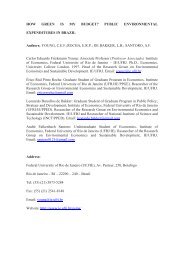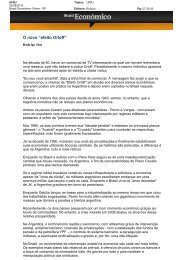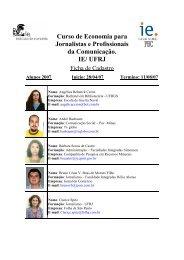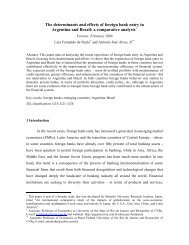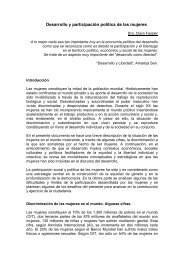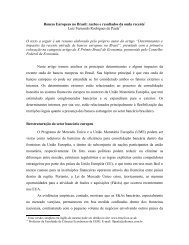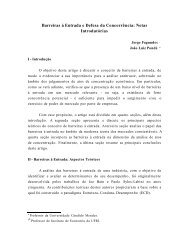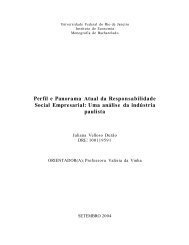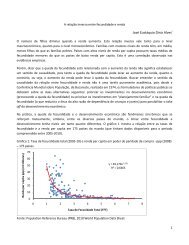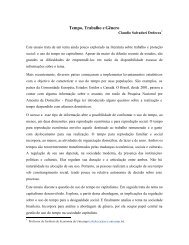Trade Integration for the Americas: What Can Economic Analysis ...
Trade Integration for the Americas: What Can Economic Analysis ...
Trade Integration for the Americas: What Can Economic Analysis ...
- No tags were found...
You also want an ePaper? Increase the reach of your titles
YUMPU automatically turns print PDFs into web optimized ePapers that Google loves.
7with <strong>the</strong> statistical testing of econometric models. Moreover, <strong>the</strong> simulation results willbe heavily dependent upon <strong>the</strong> benchmark year data, as well as <strong>the</strong> model parameters andany o<strong>the</strong>r related assumptions. Second, <strong>the</strong> aggregation in CGE models, normallymandated by data limitation considerations, may mask important effects in anysimulation. In o<strong>the</strong>r words, sectoral detail can not reasonably be expected from CGEmodels. Third, <strong>the</strong> more elaborate and detailed <strong>the</strong> CGE model, <strong>the</strong> more likely it is tobecome a “black box” <strong>for</strong> which result interpretation is difficult. Fourth, <strong>the</strong>re is no timedimension in a CGE model. The supposition is that with <strong>the</strong> imposed shock (e.g., policychange) <strong>the</strong> economy moves from one equilibrium to ano<strong>the</strong>r. How long this adjustmenttakes is a matter of judgment. Fifth, <strong>the</strong>re is no financial sector in CGE models. Sixth,and very importantly, despite ef<strong>for</strong>ts to dynamize CGE models, <strong>the</strong>y are essentiallycomparative static models.Use of CGE Models in Policy Simulations. While initially confined touniversities and research institutions, CGE models are now also widely used bygovernments to assess <strong>the</strong> impacts of policy changes. A recent survey estimated thatgovernment CGE modeling capability and use were present in at least 20 countriesaround <strong>the</strong> world. 3 Policy simulation impact analysis using CGE models has taken placeto assess trade policy changes, public finance and fiscal re<strong>for</strong>m, agriculture, migration,labor market issues, income distribution and structural re<strong>for</strong>m. With time and <strong>the</strong>improvement of modeling and computational techniques, <strong>the</strong> models have become moresophisticated, increasingly realistic and, at <strong>the</strong> same time, more difficult to interpret. The“first generation” of CGE models generally assumed that all markets were perfectlycompetitive, while a “second generation” of models has been able to include increasingreturns to scale and imperfect competition, <strong>the</strong>reby enabling <strong>the</strong> models to better reflectscale economy and competitive effects. “Third generation” CGE models have sought toendogenize some dynamic effects, including allowing <strong>for</strong> investment, productivitygrowth and externalities related to trade.When <strong>the</strong>se different generations of CGE models are used to assess <strong>the</strong> impact ofregional trade and integration arrangements, <strong>the</strong> more simple “first generation” modelsgenerally show that most RTAs have positive, but very small, aggregate welfare effects.The net effect of trade creation and trade diversion effects, as simulated with suchmodels, has generally run less than 1 percent of GDP. The use of “second generation”models have increased <strong>the</strong> measured gains to an order of about 2-3 percent of GDP, while“third generation” models have presented net gains in <strong>the</strong> magnitude of around 4-5percent of GDP. 4 A recent study of Mexico’s entrance into NAFTA, in part based upon a“third generation” CGE model, has concluded that Mexico’s GDP has increased by 4-5percent of GDP as a result of NAFTA membership. 53 Shantayanan Devarajan and Sherman Robinson, “The Influence of Computable General EquilibriumModels on Policy,” International Food Policy Research Institute, TMD Discussion Paper No. 98 (August2002).4 For a discussion, see World Bank, <strong>Trade</strong> Blocs: A World Bank Policy Research Report (New York:Ox<strong>for</strong>d University Press, 2000) and Harrison, Ru<strong>the</strong>r<strong>for</strong>d and Tarr (2004).5 World Bank, Lessons from NAFTA <strong>for</strong> Latin America and <strong>the</strong> Caribbean: A Summary of ResearchFindings (Washington: World Bank, 2003).



